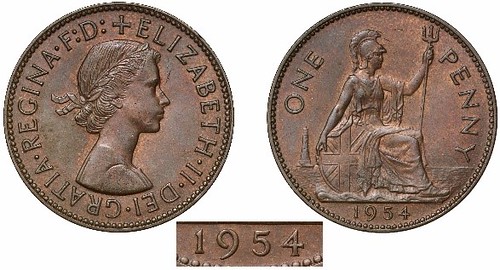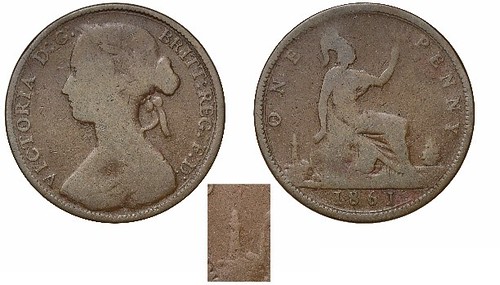
PREV ARTICLE
NEXT ARTICLE
FULL ISSUE
PREV FULL ISSUE
SOVEREIGN RARITIES WORKMAN COLLECTIONSovereign Rarities is offering a great collection of penny rarities in next month's sale. Here's the announcement. -Editor Sovereign Rarities of London UK are proud to present for auction on November 19th 2024 the Bernard Workman Collection of Bronze Penny Rarities 1860-1967 – a scintillating selection of forty of the most elusive pennies from the reigns of Queen Victoria to Queen Elizabeth II, the most valuable rarity being the unique 1954 currency Penny. After the immense output of pennies dated 1953 for the start of the reign of Elizabeth II (1952-2022) and though dies had already been prepared dated 1954 with some trial strikes prepared, it was seemingly decided not to go ahead with a regular coinage of pennies for this year and in fact for the rest of the decade. The dies and the trial strikes were defaced and destroyed, however it seems one 1954 dated striking emerged into circulation where it was discovered at some point before 1956 when it was sold to the major dealer London dealer Spink and swiftly sold on to major collector and numismatic author Charles Wilson Peck who owned one of the most comprehensive collections of the series at the time and was preparing to produce the British Museum Catalogue of Copper, Tin and Bronze coins 1558-1958. Peck owned the coin until 1963 when the Empire Coin Company of New York made him an offer he could not refuse to sell this unique coin. Empire Coin Company promoted the coin as a key rarity in their ownership and it appears for sale in their September 1965 catalogue at the sum of $30,000 in 1965 money, about £10,000 at the time far outstripping the prices of all other coins on the list, like the George IV 1826 Five Pounds which is listed for nearly ten times less, being the sort of coin which sells for £100,000 plus today. The coin did not appear for public sale again until the November 1991 Spink Coin auction 89 and this was the last occasion it was publicly offered for sale, changing hands only once privately since to Bernard Workman. Therefore the Sovereign Rarities auction 15 of the 19th November in London will represent the first time this coin has been available publicly to bid on in over thirty years and is estimated at £90,000-£120,000. We present the pennies herewith in reverse chronological order as they will be sold this way in the auction at the request of the Mr Workman, and we also highlight here some other key currency rarities in the Victoria (1837-1901) "bun" Penny series. The Heaton Mint in Birmingham, England emerged after the demise of the former Soho Mint in Birmingham run by the Boulton family when the effects and equipment of the old Soho Mint were sold off by auction on the 29th April 1850. Ralph Heaton II purchased four of the steam powered presses as well as other vital machinery at that auction and set up Ralph Heaton and Sons as a Mint in Icknield Street Birmingham and began to win contracts to produce coins for overseas nations starting in late 1850 with a token issue for Australia followed by a coinage for Chile in 1851. The rise to prominence did not go unnoticed by the Mint in London and they first subcontracted Heaton to help with large orders for British copper coinage dated 1853 and then 1856 but these were not delineated in any way. The relationship continued with the Mint to alleviate strain when required for larger demands for coinage and the first H marked pennies were produced in 1874 such as this piece offered here. There were a number of different obverse and reverse die combinations and this is one of the rarest as Freeman catalogue number 76 obverse die 7 and reverse die I, which is estimated to sell for £1,800-£2,200 on 19th November. A series of interesting patterns were produced with an alternative rendering of the currency Penny laureated head bust by Chief Engraver Leonard Charles Wyon for the dates 1862, 1865 and finally 1870 which were never adopted for currency. This treatment of the obverse with the Queen wearing a coronet upon her head was rendered by engraver T. J. Minton after a model by sculptor and artist William Theed who was a designer at Wedgewood. All three dates of the known patterns are present in the Bernard Workman collection as well as two off-metal strikes including this cupro-nickel piece. The first pattern of 1862 was produced by Minton in the year the Resident Engraver of the Mint George Wyon died. The second date for this pattern of 1865 marks the year that Minton was officially granted the post of Resident Engraver after George Wyon he likely having been acting Resident Engraver after Wyon's death in 1862. The final patterns for the Penny with this coronet obverse being dated 1870. Though the obverse portrait was not applied to British coinage, similar versions did eventually find their way onto the colonial coinages of the time for amongst others, Malta, the Strait Settlements and British Honduras. This cupro-nickel piece is graded by NGC as PF64 and estimated to sell for £6,000-£8,000 on November 19th. The selection of pennies on offer for November 19th contains four examples of the die numbered pennies all of extreme rarity. Die numbers 2, 3, 4 and 5 are the only known numbers so far seen and the Bernard Workman collection contains two examples of die 3 and one each of 2 and 4. These numbered reverses are thought to relate to a method to trace the journey of bronze coins from production to circulation, the dies being so numbered can be traced to a die making machine, its operator along with date and duration of use. The number of pennies struck from the die can measure the longevity and output which perhaps could then be extrapolated to surveys in circulation. However, the experiment on bronze coinage did not last long, die numbers only appear on some 1863 pennies (2 to 5 so far known) and for the year earlier 1862 bronze Halfpenny where some extremely rare reverse dies were lettered A, B or C by the lighthouse as a forerunner to numbering. It would seem the experimentation with bronze in this way ended not long into 1863 and was then applied immediately to gold and silver coinage instead probably as a mark of success in whatever aspects were being surveyed. The die number system appears on gold Sovereigns and Half-Sovereigns, silver Florins (on obverse die), Shillings and Sixpences all at varying times from 1863 until as late as 1880. The bronze pennies with die numbers for 1863 are all of extreme rarity and this die number 3 piece though it has not been give a numerical grade due to the digs upon the surfaces is estimated to sell for £3,000-£4,000 One of the more unusual and extremely rare date varieties for the 1863 Penny is the one that demonstrates the "open" 3 in date, where the lower loop of the 3 splay down and out to the left rather than more upward. This is the finest example that currently exists and is graded as MS63 brown at £1,500-£2,000 for the November 19th auction. The collection contains three extremely rare overdates one of which is shown below Unknown to Peck at his time of writing the British Museum Catalogue and to Michael Freeman when he prepared his earlier editions the 8 over 6 overdate for 1862 is an overdate rarity, very few of which exist in the bronze Penny series. Listed in the more recent specialised Penny references it is thought no more than seven examples exist. Estimated to sell for £1,000-£1,500 on November 19th. For bronze penny aficionados it can prove very difficult to find some of the rarest currency penny die combinations especially where obverses and reverses were not really supposed to be combined together. Though the grade is low this remains the only example known of the 1861 Penny with the earlier obverse that still carries the L C WYON engraver signature for Leonard Charles Wyon partly on the bottom truncation of the bust rather than below it or not present at all. This is combined with the latter reverse with no LCW signature on the groundline. Turning to Michael Freeman's Bronze Coinage tome one of the key references of the series this coin is the only example of Freeman number 19 which is obverse 2 combined with reverse F, it is estimated at a mere £400-600 for the 19th November auction in London. The first issues of currency bronze pennies in 1860 after the change from the bigger thicker copper issue of the decades preceding, all had a beaded border of dots within the outer rim. The latter issues of this date all have an outer border that is formed of teeth joined together side by side. There are however some rare mules that combine one side of each and the coin above demonstrates this variety in high grade MS63 brown at £3,000-4,000 This unique 1954 Penny is the key coin in this selection of pennies and we hope to share more with you week by week until the auction event on Tuesday 19th November. Please click through our advertisement in this E-Sylum newsletter to our website www.sovr.co.uk to register your interest in this sale.
Wayne Homren, Editor The Numismatic Bibliomania Society is a non-profit organization promoting numismatic literature. See our web site at coinbooks.org. To submit items for publication in The E-Sylum, write to the Editor at this address: whomren@gmail.com To subscribe go to: https://my.binhost.com/lists/listinfo/esylum All Rights Reserved. NBS Home Page Contact the NBS webmaster 
|








